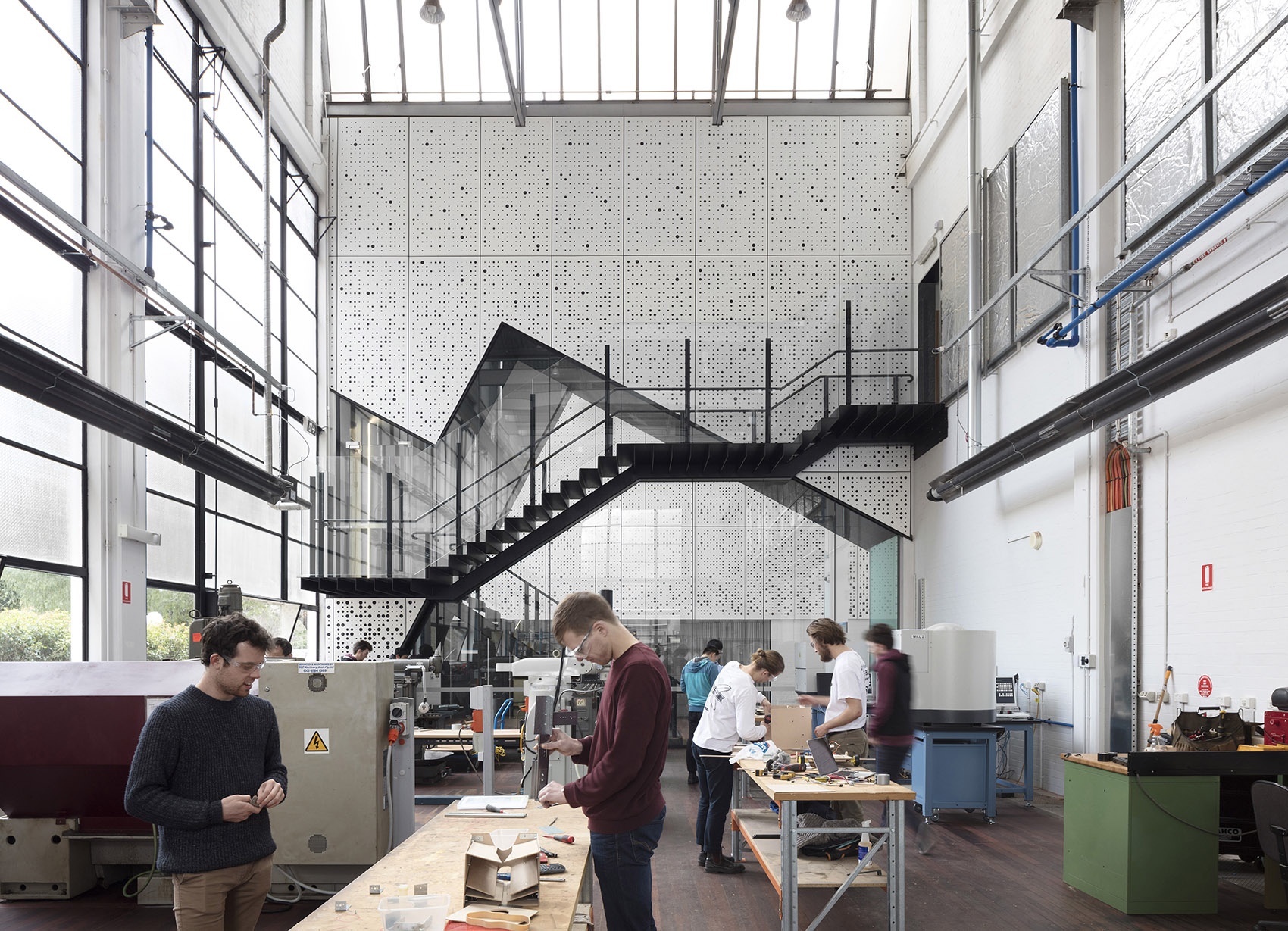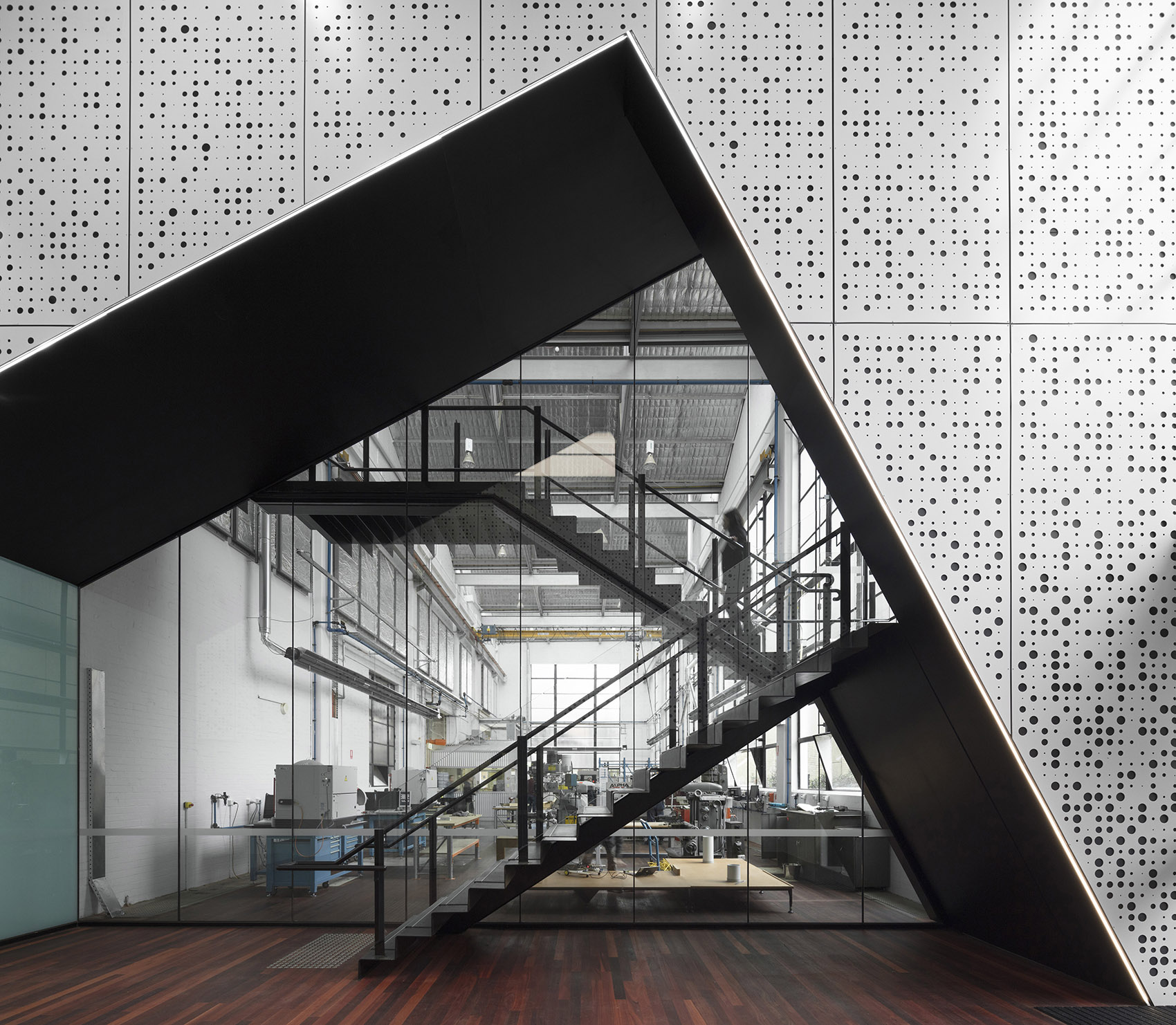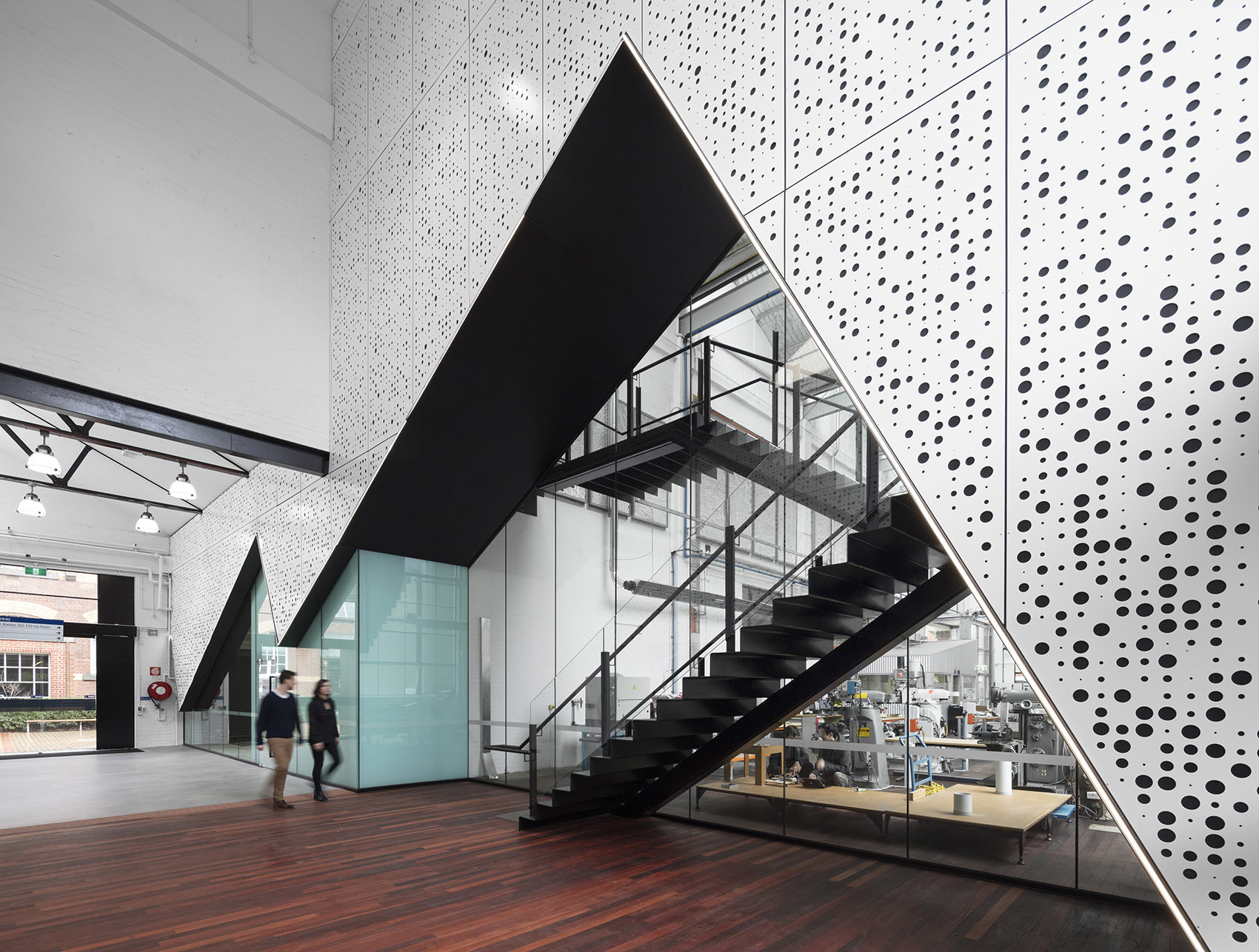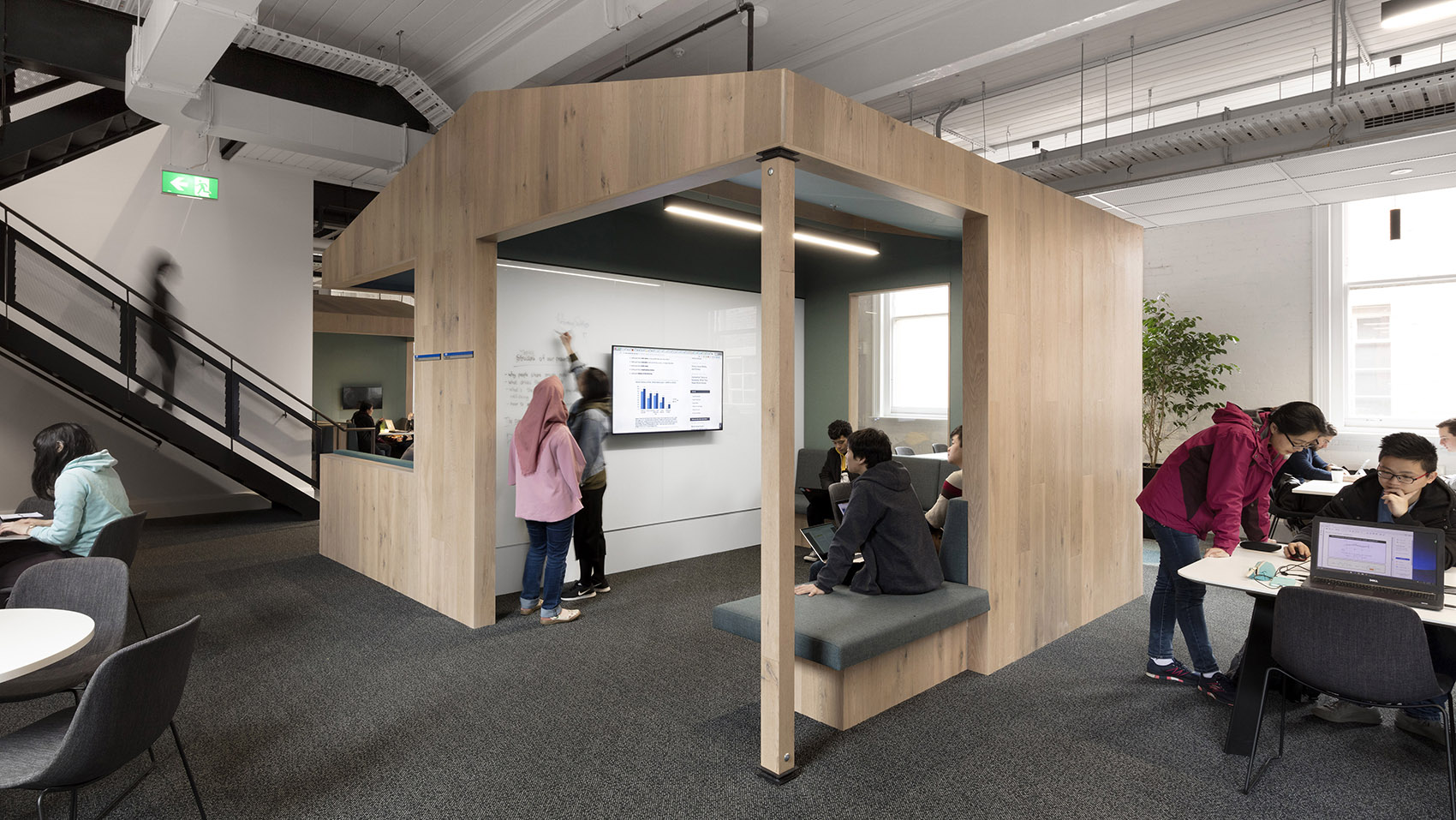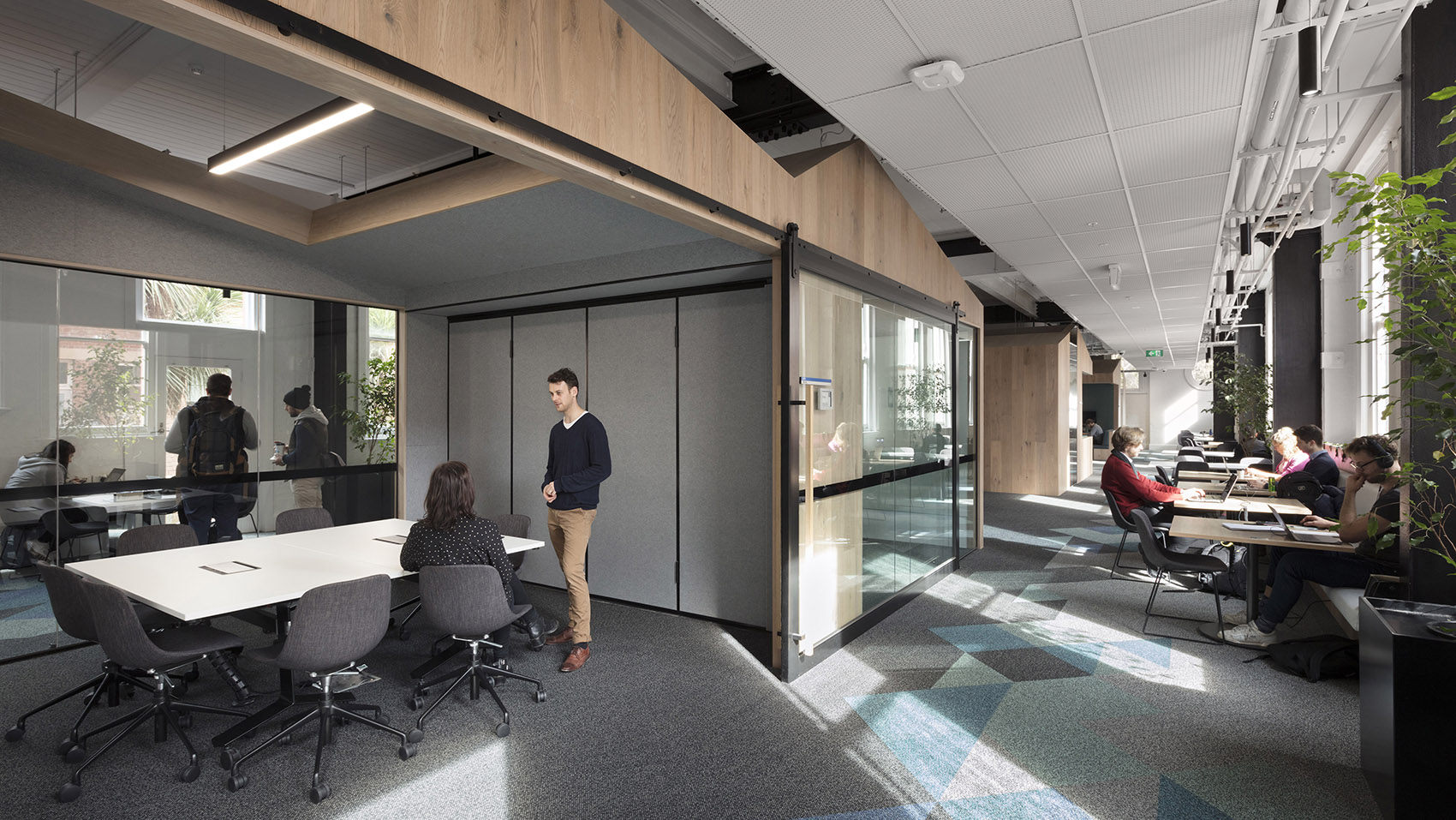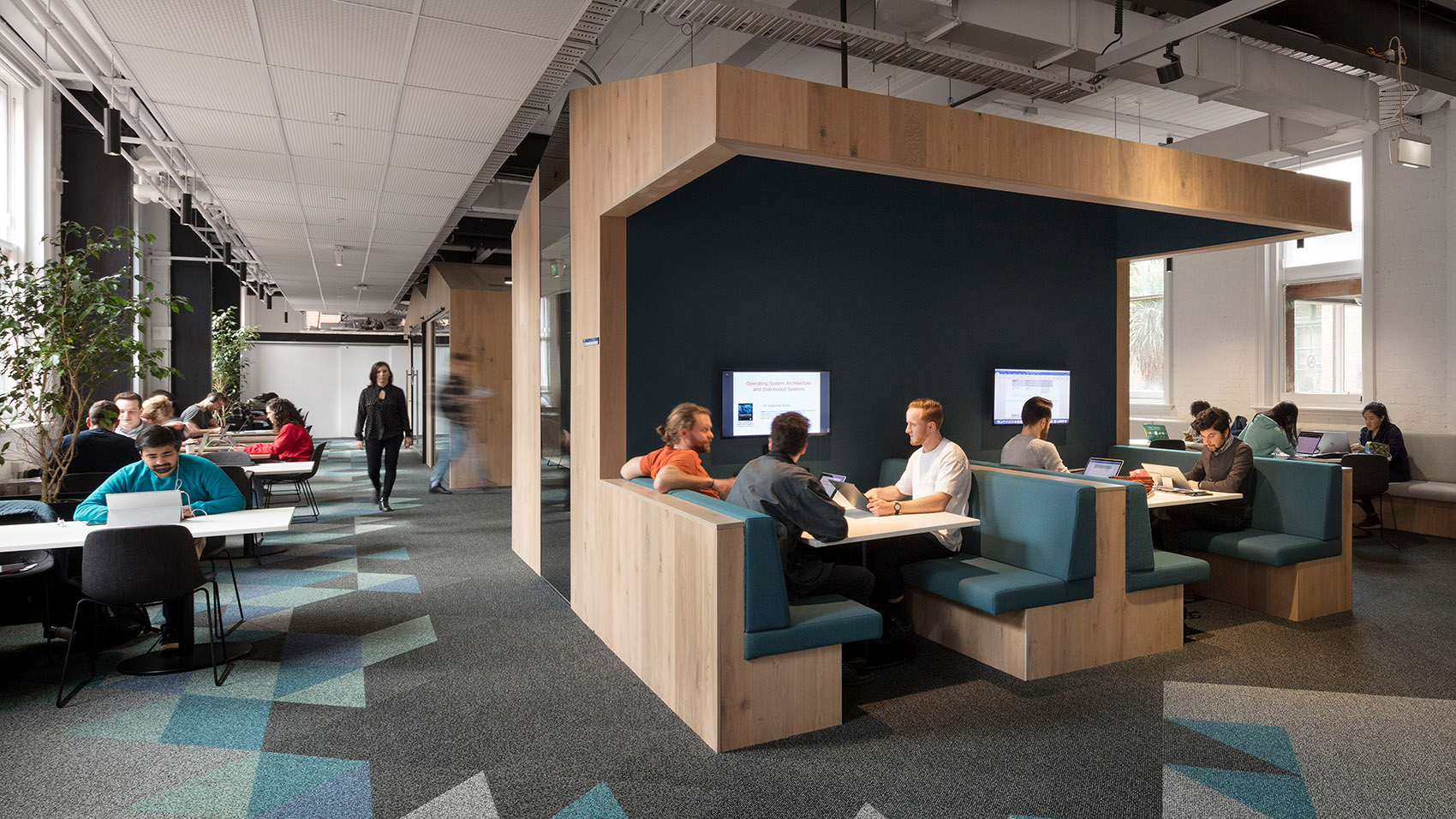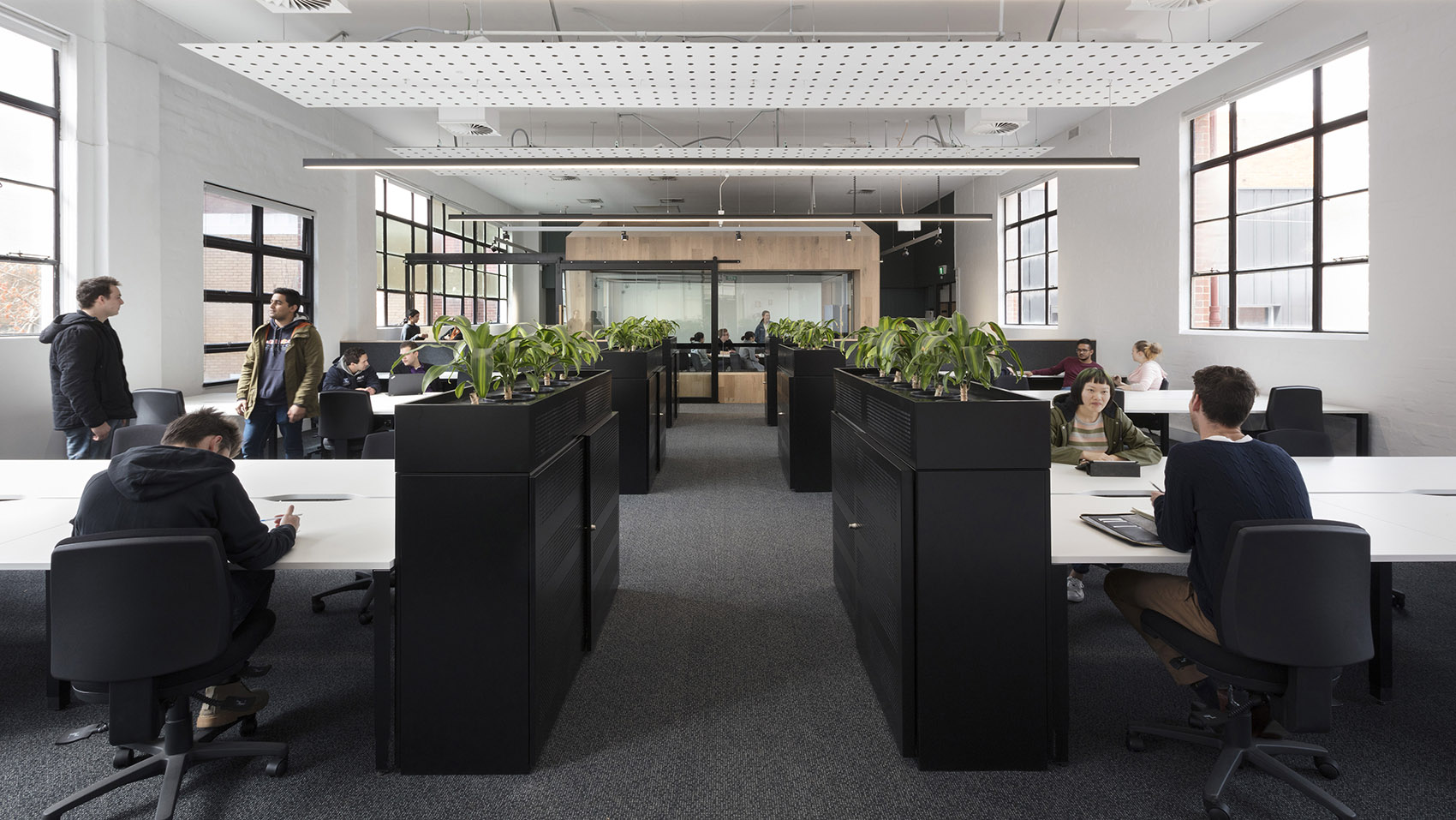继墨尔本大学工程学院项目之后,建筑事务所DesignInc再次与该大学合作,对169号教学楼和173号教学楼的北附属楼进行改造和更新。169号教学楼建于20世纪30年代,原是工程研讨空间;而173号教学楼的北附属楼则是老工程学院楼的旧址。
本项目旨在为学生们提供一系列额外的创新型活动空间,以便提高他们的新型研究能力,从而推动2025年工程学院愿景的实现。为此,建筑师们建立了一整套关键性的设计原则作为项目设计的指导方针,希望能够创建以学生为中心的教学空间。这些原则性方针包括:激发学生的企业家精神;促进人与人之间的合作;提高空间的可见性、安全性和灵活性;打造世界一流的可持续空间等。
Continuing our relationship with The University of Melbourne’s School of Engineering (MSE), this project involves the refurbishment of building 169, the original 1930s Engineering Workshop, and the north wing of building 173, Old Engineering.
The brief called for the addition of innovative student activity spaces enabling new research capabilities to fulfil MSE’s 2025 vision. We established a set of key principles to guide the design to align with student-centred pedagogies. These are: entrepreneurship, collaboration, visibility, safety and security, flexibility, world-class, and sustainability.
▼改造后169号教学楼中的工程研讨空间,the workshop space in the building 169 after renovation ©Dianna Snape
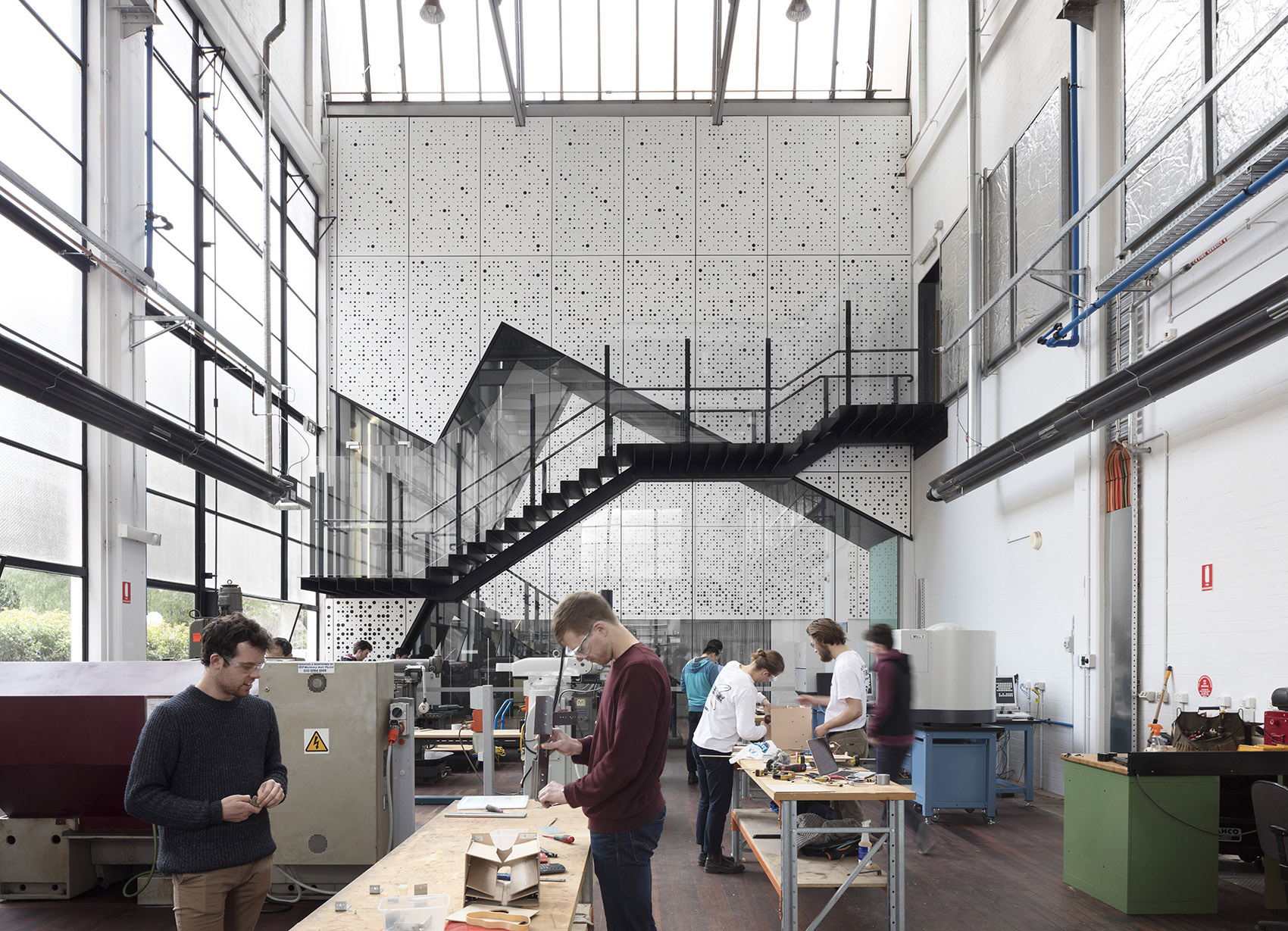
整个项目的核心理念是“将工程学作为展品”,在现代主义的研讨空间中将其展示给人们。为此,设计团队创建了一个室内的流线,将曾经处于封闭状态的研讨空间打开,让学生和路人能够尽情地观察和体验这些场所。这条室内的流线还将1888号教学楼的东花园与工程空间连接了起来,一方面加深了各空间之间的联系,另一方面又将充足的自然光线引入了内部空间。
立面的改造较为细微,主要是为了突出室内新旧功能空间(如计算机辅助康复环境和3D金属打印室等)之间的对比,起到了辅助的作用。各研讨空间通过一系列锯齿形的白色穿孔金属板来限定,呼应了该建筑体量及其天窗屋顶的工业特色。锯齿形的白色穿孔板不仅引导着人们穿梭于整个空间之中,还在体量的大小规模上协调和平衡了各个空间。
The philosophy guiding our intervention in the modernist workshop building was to ‘put engineering on display’. We created an internal linkway to open-up the previously closed-off workshop space to students and passers-by. The linkway connects the eastern garden of building 1888 to the engineering precinct – to both let in natural light and facilitate connection within the precinct.
Subtle interventions in the existing facade give way to the celebration of old and new functions inside, including a Computer-Aided Rehabilitation Environment (CAREN) and 3D metal printer. A saw-tooth form cut from white-coated perforated metal, frames the workshop – a subtle nod to the skylight roofs of industrial architecture and to the building itself. The gesture leads people through the space and negotiates the dramatic change in volume across the building to the main workshop.
▼锯齿形的白色穿孔金属板限定空间,saw-tooth form cut from white-coated perforated metals frame the workshop ©Dianna Snape
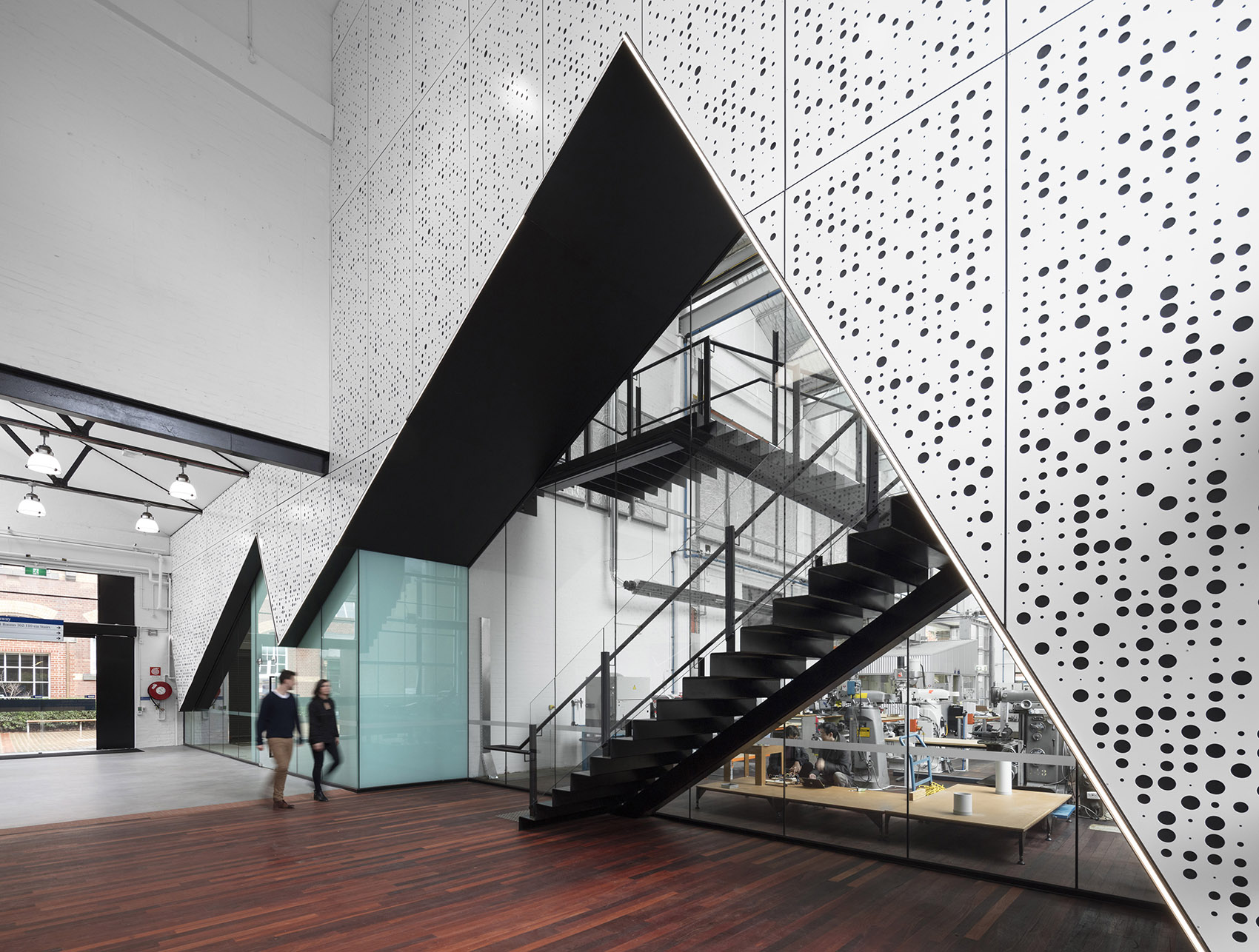
悬臂式的折叠钢楼梯从锯齿状的金属板边缘延伸出来,通向一个观景平台。该平台通过一个无框的玻璃隔墙与走廊空间分隔开来。站在这个观景平台上,人们可以俯瞰重新布局后的研讨空间。除了观景平台外,楼梯还与位于一层的企业项目团队空间相连,创造出一个全新的动态空间,为人们体验工业规模的空间、感受工业细节提供了机会。交通流线将新旧功能空间整合在了一起,通过简练的建筑语言向人们展示了本项目的核心——工程学。
A cantilevered folded steel stairway peels away from the saw-tooth, leading to a viewing platform that overlooks the reorganised workshop, while a frameless glass screen separates it from the linkway. Beyond the viewing platform, the stairway connects to the entrepreneurial project team spaces on level 1 – providing a new and dynamic space to experience the industrial scale and detail. The linkway weaves together old and new with a stripped back architectural language which reflects engineering at its core.
▼锯齿状的白色金属穿孔板和悬臂式的折叠钢制楼梯,the white-coated perforated metals in the saw-tooth form and the cantilevered folded steel stairway ©Dianna Snape
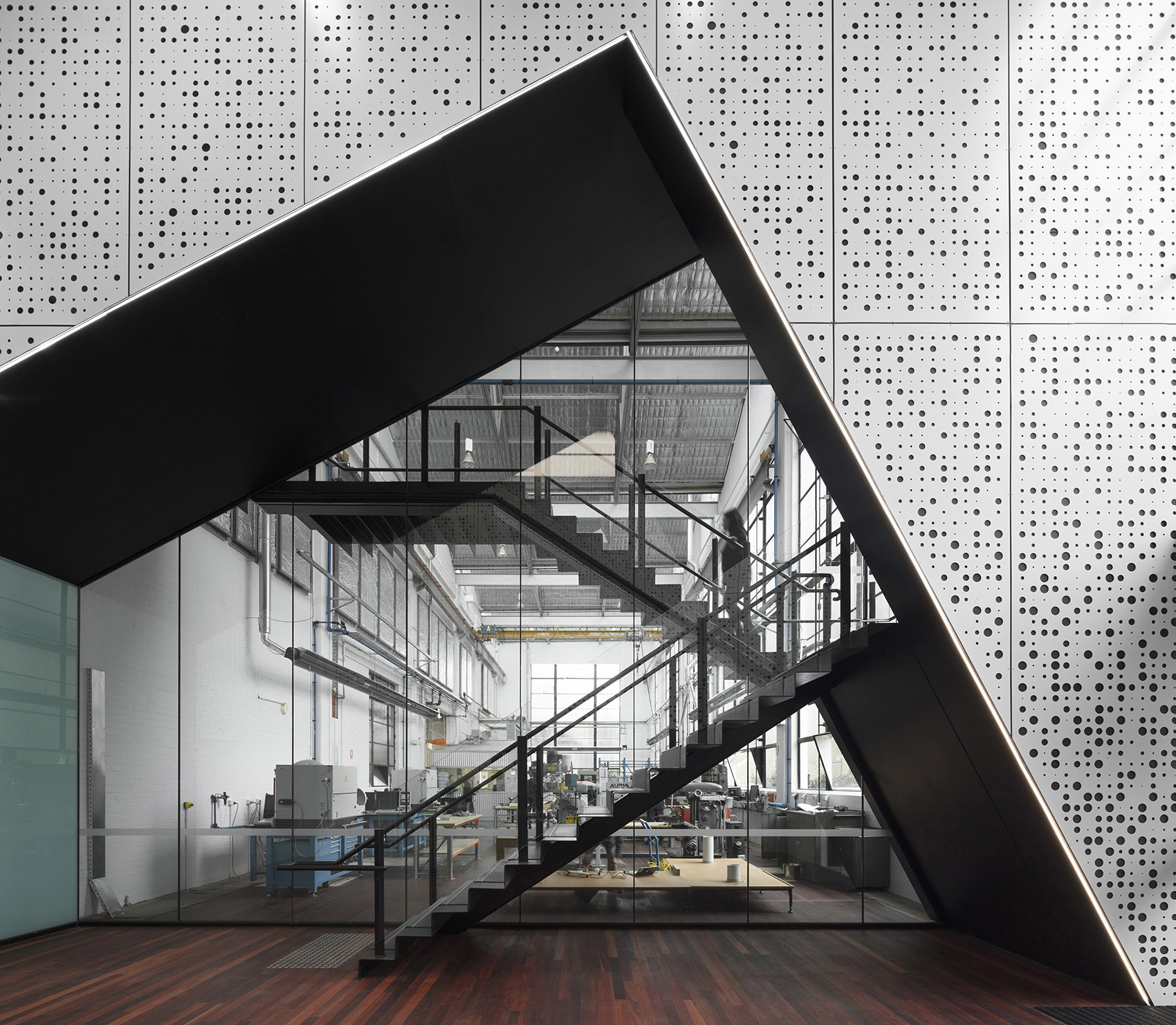
对于老工程学院楼的北附属楼来说,其更新改造的关键点则在于一系列“屋中之屋”般的会议室空间。设计团队对原建筑的结构体系进行了调整,从而打开了原空间并提高了空间的灵活性,为该建筑的未来运营奠定了坚实的基础。
The key architectural concept in the north wing refurbishment of the Old Engineering building is the central spine of meeting room pods or ‘rooms within the room.’ Structural modifications were made to open-up the floor plate providing flexibility and allowing the building to continue to operate for another 100+ years.
▼“屋中之屋”般的木制会议室空间,the meeting room pods or ‘wooden rooms within the room’ ©Dianna Snape
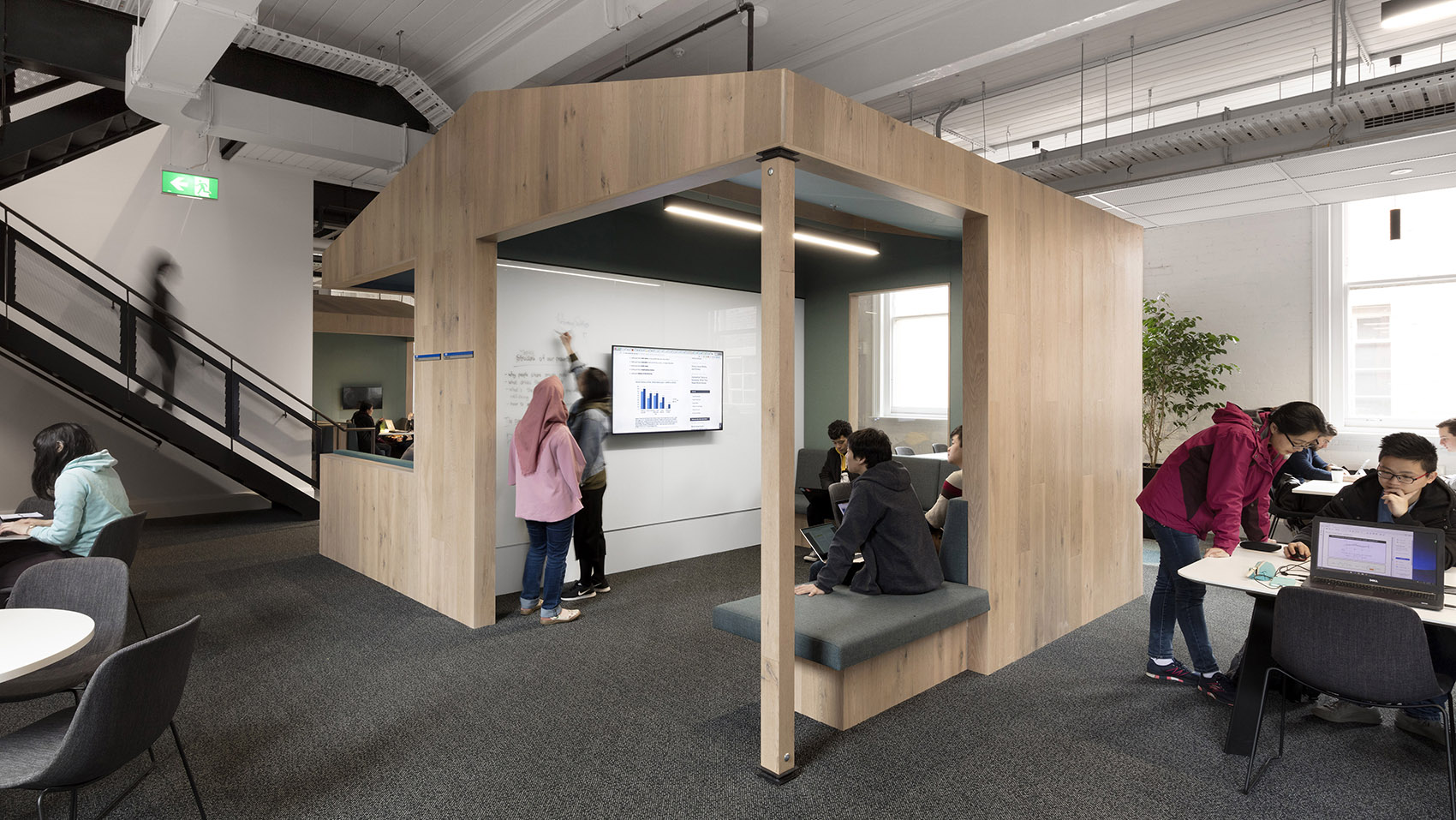
木制的会议室体量并不与原建筑结构接触,其大小由现有空间的规模来决定。因此,设计团队得以在原空间的内部加入一系列钢制的支撑构件,以呼应工程学的内涵。
The pods stand in isolation from the building fabric and give context to the scale of the existing building. This allows for interior expression of the large steel portals supporting the structure; a celebration of engineering.
▼木制的会议室体量并不与原建筑结构接触,the pods stand in isolation from the building fabric ©Dianna Snape

▼木制的会议室体量与大型的钢制支撑构件,the wooden meeting room and the large steel supporting elements ©Dianna Snape

木饰面的会议室中设有各种高科技的设备,可供团体预订使用。非正式的座椅空间沿着会议室的外侧排列,不仅丰富了空间的灵活性,还为学生们提供了轻松平等的学习环境。交通空间的地板上铺设着三角形图案的定制地毯。随着交通空间向功能空间的过渡,地毯也逐渐变为纯色。这种地面的处理手法提供了一种视觉暗示,可以在没有任何隔墙的情况下分隔空间,有助于提升高使用率的学生空间的管理效率。铺设着地毯的地面与空间隔声层、自然光线和室内植物的平静色调相得益彰,共同创造了一个协作的学习和工作环境,有助于培养学生们的创造力和企业家精神,以满足行业的需要。
The timber-clad pods accommodate a diverse mix of technology-rich, bookable group workspaces. Informal settings line the perimeter of the space, providing an extra layer of flexibility. Students can choose how they study in an environment that is informal, non-hierarchical, and relaxed. Custom carpet with a biophilic triangular pattern is integrated to define the circulation paths within the area graduating to a solid colour through the centre of the space. The pattern is a visual cue reinforcing visual cues to zoning within the space, aiding the informal management of the high-use student space. The floor complements a calming palette of acoustic surfaces, natural daylight, and internal plantings – all working together to create a collaborative environment that fosters the creativity and entrepreneurship the industry demands.
▼非正式的座椅空间沿着会议室的外侧排列,informal settings line the perimeter of the space ©Dianna Snape
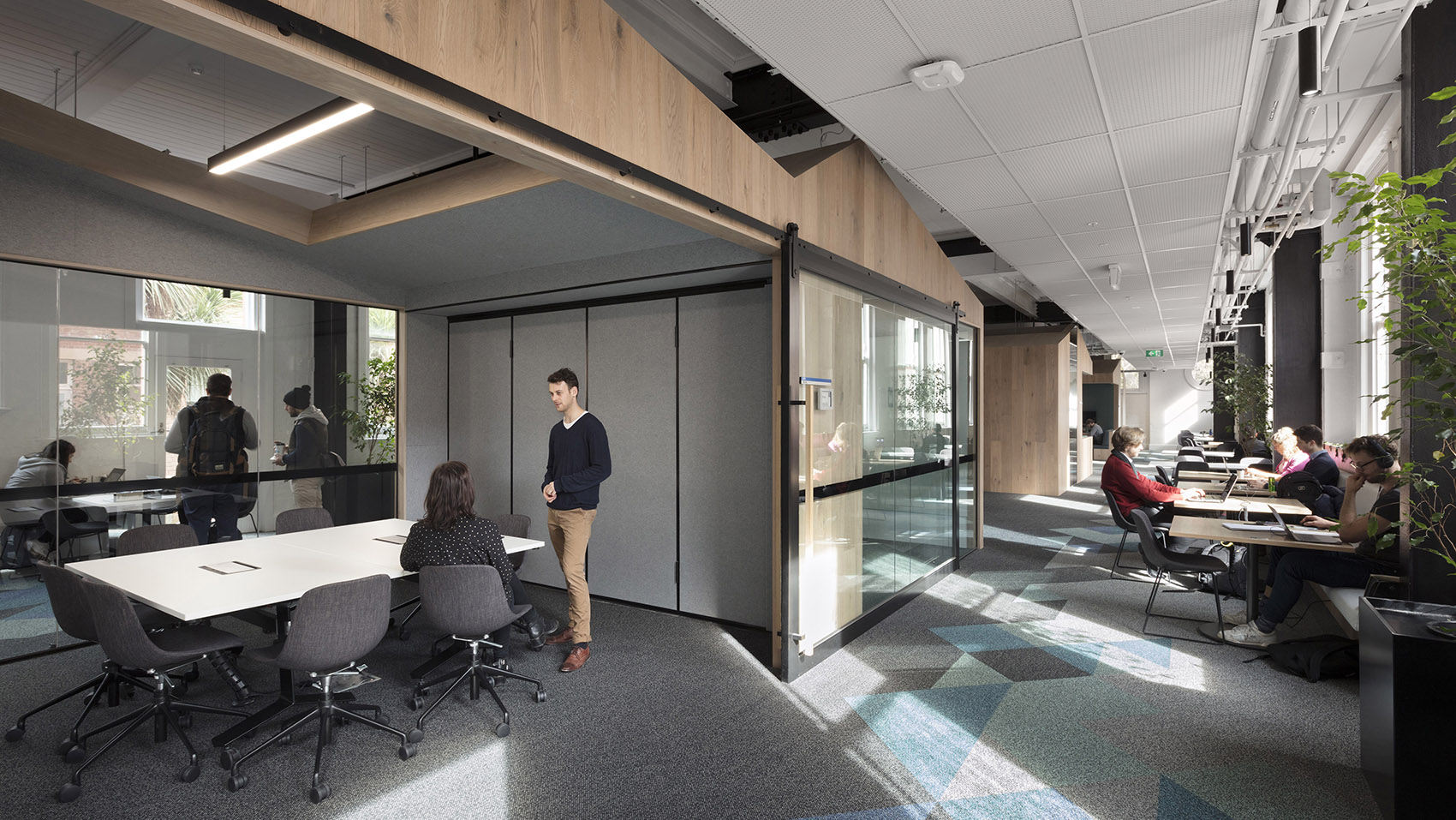
▼交通空间的地板上铺设着三角形图案的定制地毯,custom carpet with a biophilic triangular pattern is integrated to define the circulation paths ©Dianna Snape
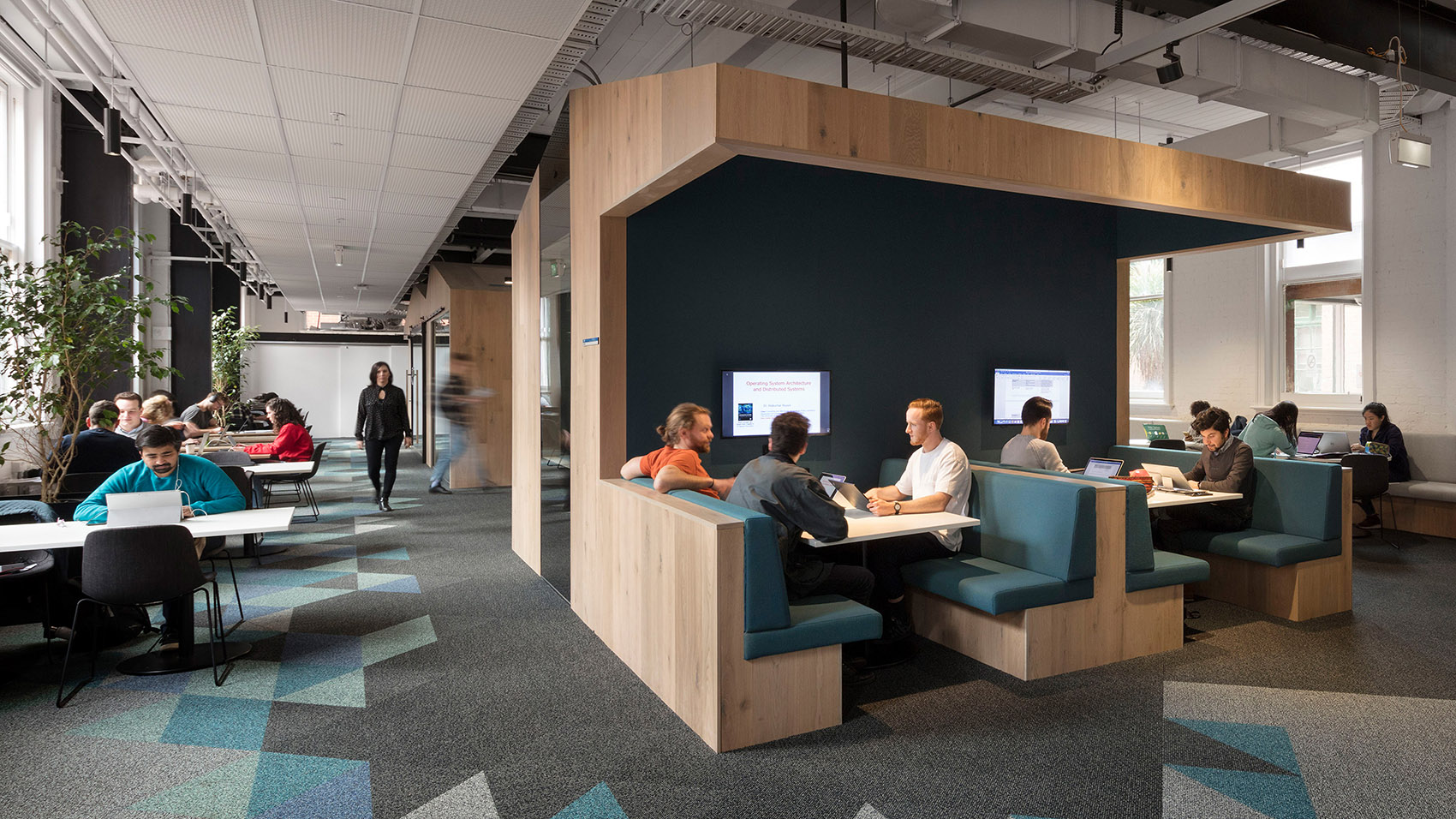
▼工作空间采用纯色的地毯,the working space with a solid colour ©Dianna Snape
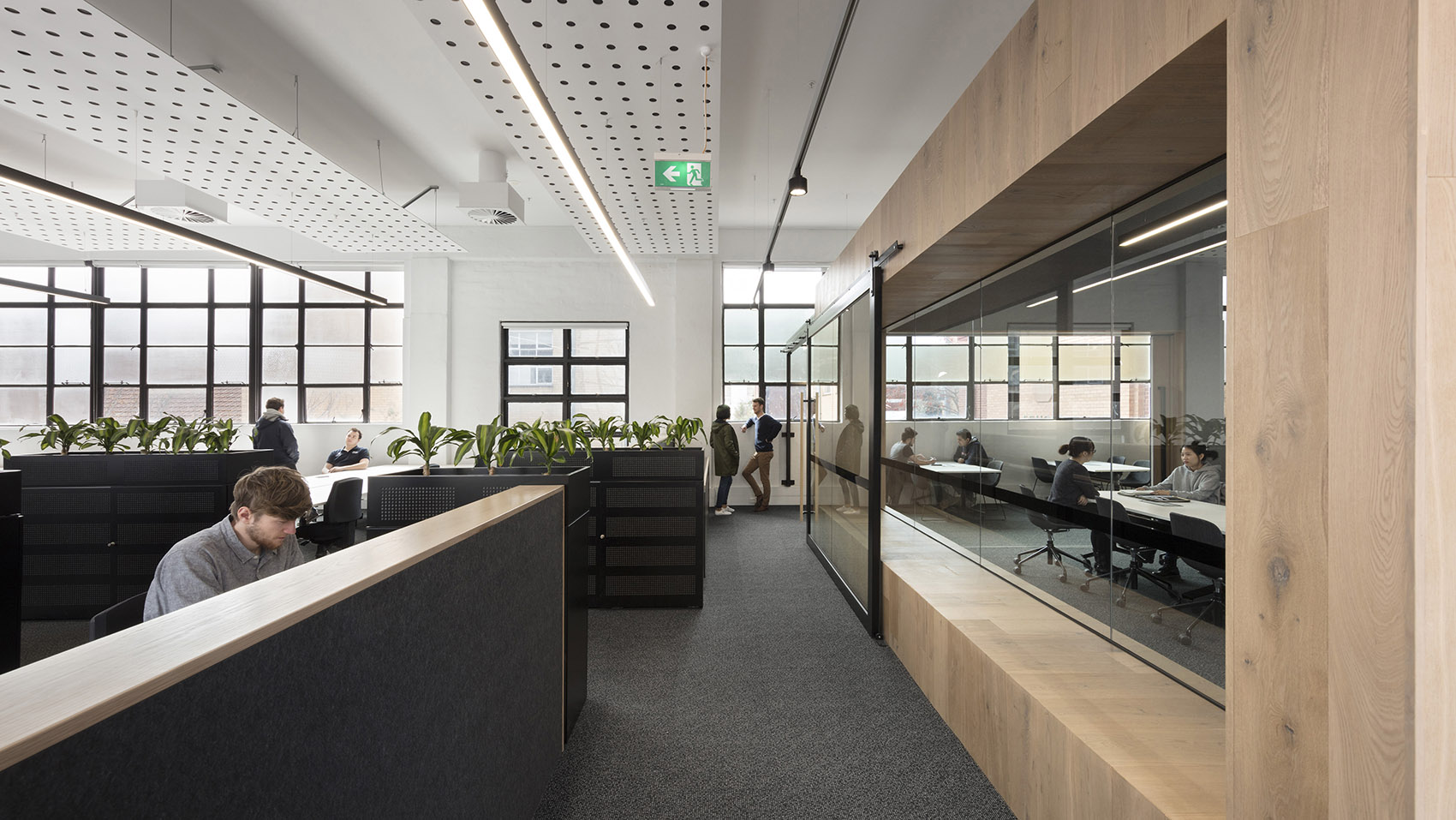
▼室内空间中设有绿植,the interior space with plants ©Dianna Snape
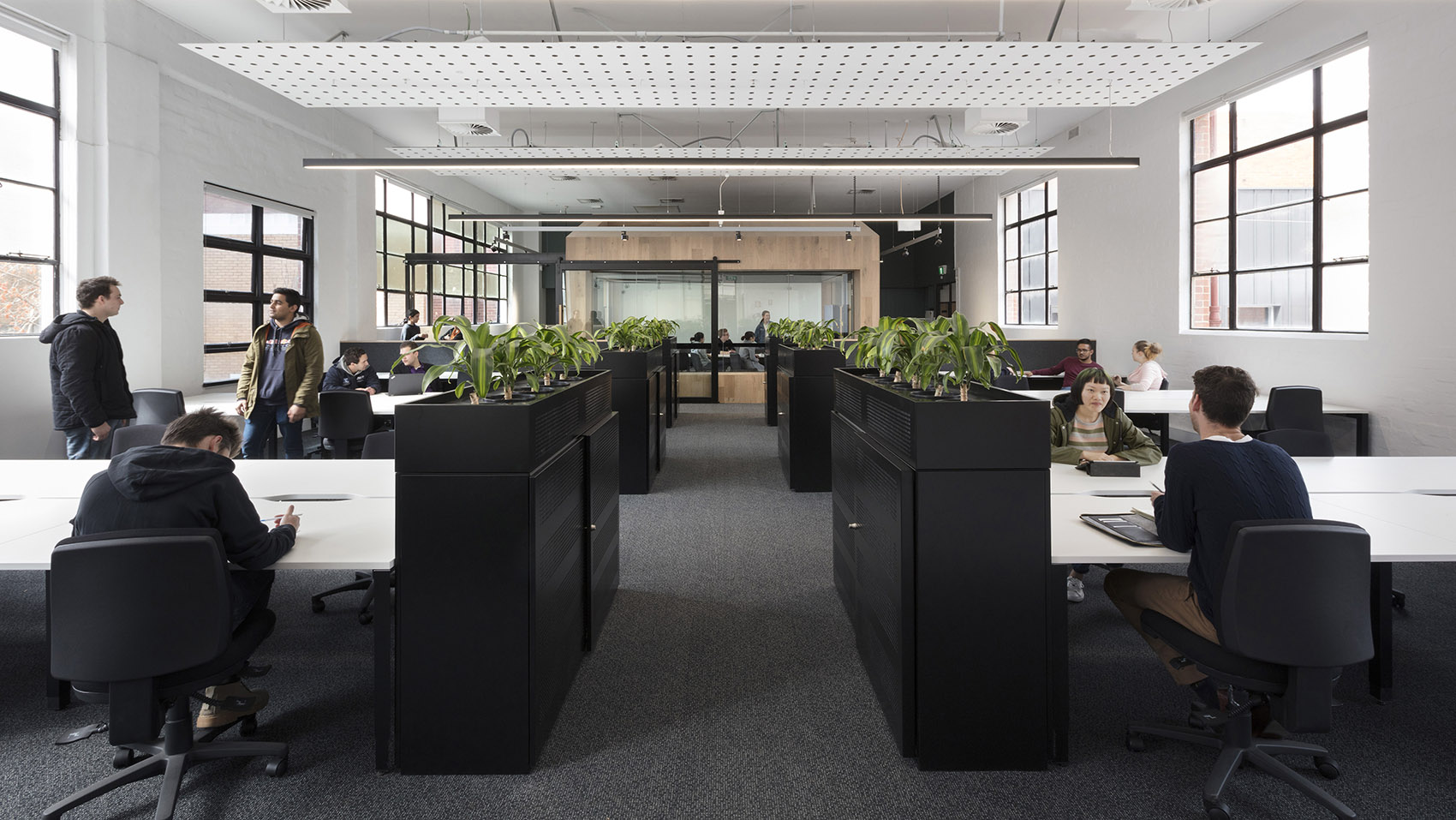
通过战略性的重新规划,设计团队在老工程学院楼和原工程研讨车间内加入了一系列新型的功能和教学空间,不仅延长了这两座教学楼的使用年限,更最大限度地避免了拆除旧楼、建造新楼所导致的碳排放量飙升的情况。
本次改造更新为学生们提供了氛围更好的学习和工作空间:可通向景观庭院的廊道、丰富的自然光线、可控范围内的眩光,以及可减少空气中的灰尘、过滤污染物和调节室内温度的室内绿植等都创造了舒适的环境。此外,设计团队还精心挑选了以下材料和家具:低挥发性的涂料和密封剂;带有可回收成分的弹性地板饰面、隔声层和纺织品等;绿色星级认证的地毯砖;FSC认证的工程木材;经GECA批准的工作站和工作椅;以及经AFRDI认证的可持续家具等。
此外,设计团队还在空间中使用了一系列节能性设施:如用新的节能LED灯具替换原有的照明设备、用新的节水配件替换原有的卫浴设施、以及用简单高效的CHW/HHW系统替换原有的机械系统等。
With strategic replanning, we were able to refurbish Old Engineering Building and the Engineering Workshop to accommodate new programs and pedagogies, extending the life of two significant buildings on campus and minimising the significant carbon emissions associated with demolition and new building works.
Refurbishment has increased student amenity with access to landscaped courtyards, increased access to natural daylight, glare control and internal plantings to reduce airborne dust, filter pollutants and moderate temperatures. We carefully selected materials and furniture, using: low VOC paints and sealers; resilient floor finishes, acoustic linings, and textiles with post-consumer or production recycled content; green Star-approved carpet tiles; FSC-certified engineered timber; GECA-approved workstations and task chairs; AFRDI-certified sustainable furniture products.
Building services upgrades included replacing old light fittings with new, energy-efficient LED lighting and controls, old sanitary fittings with new water-efficient fittings, and replacing the myriad existing mechanical services with a single, efficient CHW/HHW system.
Project team: DesignInc DesignInc Project Team: Cameron Smith, Simon Bennett,Sereni Naidoo, Christon Batey-Smith, Sally Brincat, Jane Sayers, Simon McKeown, James McCutchan, Clare Barclay, Robert Duffield, Sonya Montgomerie Services Consultant: Meinhardt Quantity Surveyor: Slattery Project Manager: Root Partnerships Building Surveyor: McKenzie Group Landscape: Outlines Structural Consultant: Irwinconsult Project size: 2100 m2 Project Budget: $8300000 Completion date: 2017
